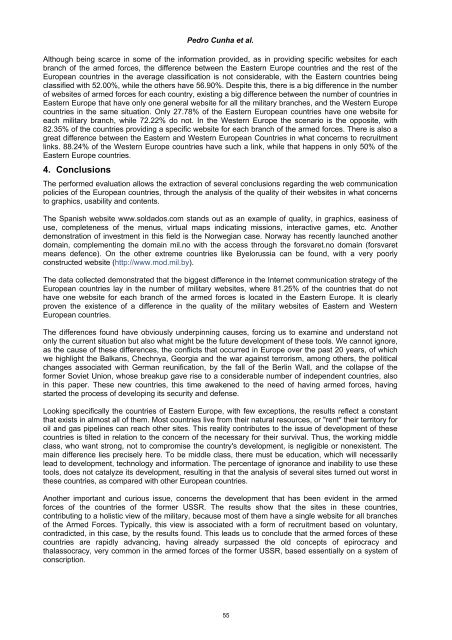(in) Security - Academic Conferences Limited
(in) Security - Academic Conferences Limited
(in) Security - Academic Conferences Limited
Create successful ePaper yourself
Turn your PDF publications into a flip-book with our unique Google optimized e-Paper software.
Pedro Cunha et al.<br />
Although be<strong>in</strong>g scarce <strong>in</strong> some of the <strong>in</strong>formation provided, as <strong>in</strong> provid<strong>in</strong>g specific websites for each<br />
branch of the armed forces, the difference between the Eastern Europe countries and the rest of the<br />
European countries <strong>in</strong> the average classification is not considerable, with the Eastern countries be<strong>in</strong>g<br />
classified with 52.00%, while the others have 56.90%. Despite this, there is a big difference <strong>in</strong> the number<br />
of websites of armed forces for each country, exist<strong>in</strong>g a big difference between the number of countries <strong>in</strong><br />
Eastern Europe that have only one general website for all the military branches, and the Western Europe<br />
countries <strong>in</strong> the same situation. Only 27.78% of the Eastern European countries have one website for<br />
each military branch, while 72.22% do not. In the Western Europe the scenario is the opposite, with<br />
82.35% of the countries provid<strong>in</strong>g a specific website for each branch of the armed forces. There is also a<br />
great difference between the Eastern and Western European Countries <strong>in</strong> what concerns to recruitment<br />
l<strong>in</strong>ks. 88.24% of the Western Europe countries have such a l<strong>in</strong>k, while that happens <strong>in</strong> only 50% of the<br />
Eastern Europe countries.<br />
4. Conclusions<br />
The performed evaluation allows the extraction of several conclusions regard<strong>in</strong>g the web communication<br />
policies of the European countries, through the analysis of the quality of their websites <strong>in</strong> what concerns<br />
to graphics, usability and contents.<br />
The Spanish website www.soldados.com stands out as an example of quality, <strong>in</strong> graphics, eas<strong>in</strong>ess of<br />
use, completeness of the menus, virtual maps <strong>in</strong>dicat<strong>in</strong>g missions, <strong>in</strong>teractive games, etc. Another<br />
demonstration of <strong>in</strong>vestment <strong>in</strong> this field is the Norwegian case. Norway has recently launched another<br />
doma<strong>in</strong>, complement<strong>in</strong>g the doma<strong>in</strong> mil.no with the access through the forsvaret.no doma<strong>in</strong> (forsvaret<br />
means defence). On the other extreme countries like Byelorussia can be found, with a very poorly<br />
constructed website (http://www.mod.mil.by).<br />
The data collected demonstrated that the biggest difference <strong>in</strong> the Internet communication strategy of the<br />
European countries lay <strong>in</strong> the number of military websites, where 81.25% of the countries that do not<br />
have one website for each branch of the armed forces is located <strong>in</strong> the Eastern Europe. It is clearly<br />
proven the existence of a difference <strong>in</strong> the quality of the military websites of Eastern and Western<br />
European countries.<br />
The differences found have obviously underp<strong>in</strong>n<strong>in</strong>g causes, forc<strong>in</strong>g us to exam<strong>in</strong>e and understand not<br />
only the current situation but also what might be the future development of these tools. We cannot ignore,<br />
as the cause of these differences, the conflicts that occurred <strong>in</strong> Europe over the past 20 years, of which<br />
we highlight the Balkans, Chechnya, Georgia and the war aga<strong>in</strong>st terrorism, among others, the political<br />
changes associated with German reunification, by the fall of the Berl<strong>in</strong> Wall, and the collapse of the<br />
former Soviet Union, whose breakup gave rise to a considerable number of <strong>in</strong>dependent countries, also<br />
<strong>in</strong> this paper. These new countries, this time awakened to the need of hav<strong>in</strong>g armed forces, hav<strong>in</strong>g<br />
started the process of develop<strong>in</strong>g its security and defense.<br />
Look<strong>in</strong>g specifically the countries of Eastern Europe, with few exceptions, the results reflect a constant<br />
that exists <strong>in</strong> almost all of them. Most countries live from their natural resources, or "rent" their territory for<br />
oil and gas pipel<strong>in</strong>es can reach other sites. This reality contributes to the issue of development of these<br />
countries is tilted <strong>in</strong> relation to the concern of the necessary for their survival. Thus, the work<strong>in</strong>g middle<br />
class, who want strong, not to compromise the country's development, is negligible or nonexistent. The<br />
ma<strong>in</strong> difference lies precisely here. To be middle class, there must be education, which will necessarily<br />
lead to development, technology and <strong>in</strong>formation. The percentage of ignorance and <strong>in</strong>ability to use these<br />
tools, does not catalyze its development, result<strong>in</strong>g <strong>in</strong> that the analysis of several sites turned out worst <strong>in</strong><br />
these countries, as compared with other European countries.<br />
Another important and curious issue, concerns the development that has been evident <strong>in</strong> the armed<br />
forces of the countries of the former USSR. The results show that the sites <strong>in</strong> these countries,<br />
contribut<strong>in</strong>g to a holistic view of the military, because most of them have a s<strong>in</strong>gle website for all branches<br />
of the Armed Forces. Typically, this view is associated with a form of recruitment based on voluntary,<br />
contradicted, <strong>in</strong> this case, by the results found. This leads us to conclude that the armed forces of these<br />
countries are rapidly advanc<strong>in</strong>g, hav<strong>in</strong>g already surpassed the old concepts of epirocracy and<br />
thalassocracy, very common <strong>in</strong> the armed forces of the former USSR, based essentially on a system of<br />
conscription.<br />
55

















